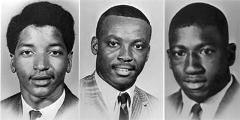It was a simple request by students at historically Black South Carolina State College in 1968. They wanted to bowl but the local alley in Orangeburg, the town where the college is located, barred Blacks despite the fact that the Civil Rights Act of 1964 seemingly required equal access and accommodations. So, students were forced to travel 40 miles to Columbia because Floyd’s All Star Bowling Lanes was intent on maintaining the artificial barriers of Jim Crow despite the fact that other facets of life in South Carolina were working to reconcile the new reality of equality.
In February of 1968 students had reached the point of exasperation over the manner in which the local bowling establishment was treating them. Sadly, in years past the students at South Carolina State received little support from the college administration. In fact, former President Benner C. Turner had discouraged student activism, opposed the formation of a campus NAACP chapter, and constructed a barbed wire fence separating the college from neighboring Claflin College, another historically Black institution. Turner became the object of student protests and eventually resigned under pressure, replaced by the more progressive M. Maceo Nance who had been the vice president of finance at the college.
A number of factors contributed to the growing unrest of the student body in 1968. The civil rights movement had awakened demands for justice among young Blacks and the cry of “Black Power” came to represent the impatience of Black youth. The arrival of Cleveland Sellers, a member of the Student Nonviolent Coordinating Committee (SNCC) on campus also heightened sensitivities to the injustice of being denied access to a local business establishment. The owner of Frank’s All Star Bowling Lanes had replaced the “White’s Only” sign on the door of his establishment with one that declared “Privately Owned,” and claimed his business was exempt from the provisions of the Civil Rights Act.
 On February 5 students decided to protest at the bowling alley and entered the business, demanding to be served at the lunch counter (the one area of the alley presumably falling under the Civil Rights Act public accommodation mandate) and to bowl. The next day, February 6, students returned and a violent confrontation ensued, with several female students brutally beaten by police. Over the next 24 hours tensions increased, with local government officials and police raising the stakes by bringing in hundreds of National Guardsmen and highway police into Orangeburg. By Thursday, February 8, the makings of a tragedy were well in place.
On February 5 students decided to protest at the bowling alley and entered the business, demanding to be served at the lunch counter (the one area of the alley presumably falling under the Civil Rights Act public accommodation mandate) and to bowl. The next day, February 6, students returned and a violent confrontation ensued, with several female students brutally beaten by police. Over the next 24 hours tensions increased, with local government officials and police raising the stakes by bringing in hundreds of National Guardsmen and highway police into Orangeburg. By Thursday, February 8, the makings of a tragedy were well in place.
On February 8 students were still seething over the indignity of having been denied access to the bowling alley. Students from South Carolina State, Claflin and some from high school had assembled on the South Carolina State campus. Some students decided to vent their frustration by building a bonfire on the campus. There were thoughts of returning to the bowling alley but police had closed it to prevent another incident. Meanwhile, Orangeburg had become an armed encampment with police swarming the town and encircling the South Carolina State campus, and some whites trying to incite the Black students. As students milled around the campus, an order was given for the fire department to douse the bonfire. It served as the tipping point and a police officer was badly injured by an object that had been thrown by one of the students angry at the sight of the fire truck and police officers. Suddenly confusion reigned as police mistakenly believed an officer had been shot. In a flash the police opened fire and bullets hailed, hitting students running for cover in a chaotic scene. In the aftermath, an 18 year-old freshman Samuel Hammond, 18 year-old sophomore Henry Smith and 17 year-old high school student Delano Middleton were killed. Middleton, the son of a college maid, died holding his mother’s hand at the hospital. Scores of students were severely injured, including a pregnant student who was beaten by police and later suffered a miscarriage.
What is now known as the “Orangeburg Massacre” remains one of the most shameful episodes of racism in modern American history but receives scant attention when compared to other campus incidents such as the killing of students at Kent State in Ohio.

today in black history
April 24, 2024
The United Negro College Fund (UNCF) was incorporated on this date in 1927 with 27 member colleges.
Black History Revised
POSTED: February 10, 2012, 12:00 am





























